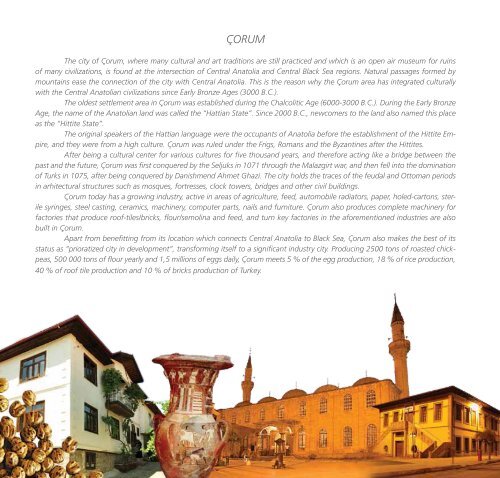Create successful ePaper yourself
Turn your PDF publications into a flip-book with our unique Google optimized e-Paper software.
ÇORUM<br />
The city of Çorum, where many cultural and art traditions are still practiced and which is an open air museum for ruins<br />
of many civilizations, is found at the intersection of Central Anatolia and Central Black Sea regions. Natural passages formed by<br />
mountains ease the connection of the city with Central Anatolia. This is the reason why the Çorum area has integrated culturally<br />
with the Central Anatolian civilizations since Early Bronze Ages (3000 B.C.).<br />
The oldest settlement area in Çorum was established during the Chalcolitic Age (6000-3000 B.C.). During the Early Bronze<br />
Age, the name of the Anatolian land was called the “Hattian State”. Since 2000 B.C., newcomers to the land also named this place<br />
as the “Hittite State”.<br />
The original speakers of the Hattian language were the occupants of Anatolia before the establishment of the Hittite Empire,<br />
and they were from a high culture. Çorum was ruled under the Frigs, Romans and the Byzantines after the Hittites.<br />
After being a cultural center for various cultures for five thousand years, and therefore acting like a bridge between the<br />
past and the future, Çorum was first conquered by the Seljuks in 1071 through the Malazgirt war, and then fell into the domination<br />
of Turks in 1075, after being conquered by Danishmend Ahmet Ghazi. The city holds the traces of the feudal and Ottoman periods<br />
in arhitectural structures such as mosques, fortresses, clock towers, bridges and other civil buildings.<br />
Çorum today has a growing industry, active in areas of agriculture, feed, automobile radiators, paper, holed-cartons, sterile<br />
syringes, steel casting, ceramics, machinery, computer parts, nails and furniture. Çorum also produces complete machinery for<br />
factories that produce roof-tiles/bricks, flour/semolina and feed, and turn key factories in the aforementioned industries are also<br />
built in Çorum.<br />
Apart from benefitting from its location which connects Central Anatolia to Black Sea, Çorum also makes the best of its<br />
status as “prioratized city in development”, transforming itself to a significant industry city. Producing 2500 tons of roasted chickpeas,<br />
500 000 tons of flour yearly and 1,5 millions of eggs daily, Çorum meets 5 % of the egg production, 18 % of rice production,<br />
40 % of roof tile production and 10 % of bricks production of Turkey.<br />
5


